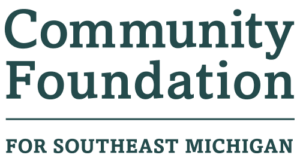
Photo: Students display the medicine pouches they made as part of the Urban Native Youth Experience Curriculum at American Indian Health & Family Services in Detroit. The nonprofit developed the innovative curriculum with support from the Community Foundation for Southeast Michigan.
This story was first published in the Spring 2024 REPORT newsletter.
A Native American medicine pouch has deep cultural significance. Each pouch contains sacred items that have personal meaning for the wearer. These include tobacco, sweet grass, sage, cedar or other materials.
For the young people who make them during one of the Urban Native Youth Experience Curriculum’s many lessons, the pouches also carry cultural connections that can boost their well-being.
American Indian Health & Family Services in Detroit developed the innovative curriculum, with financial support from the Community Foundation for Southeast Michigan, to promote resilience among urban Native youth and to create a model that similar communities nationwide can utilize.
The nontraditional curriculum meets urban Native youth where they are to support their mental health, encourage their academic and career aspirations, and celebrate their culture’s wisdom.
Nonprofit tackles systemic health challenges
American Indian Health & Family Services, which developed the Urban Native Youth Experience Curriculum, was established in 1978. The nonprofit provides medical services, behavioral health care and community wellness programming, regardless of clients’ ability to pay. It integrates traditional Native American healing and spiritual practices with contemporary Western medicine. American Indian Health & Family Services serves approximately 2,000 of the 50,000 Native Americans from all seven counties in southeast Michigan, including residents of various underserved populations and members of more than 60 tribes.
During the past century, many Native Americans were forced to relocate to urban areas due to government policy, lack of economic and educational opportunities, and limited access to health care and other services. According to the U.S. Department of Health and Human Services Office of Minority Health, approximately 70 percent of Native Americans live in urban areas.
Compared to the general population, Native Americans living in urban settings have a 33 percent higher infant mortality rate and a 178 percent higher death rate due to alcoholism, and one-third of the population is affected by depression, according to the National Council of American Indian Health.
Despite these deep-seated, systemic challenges, less than half of 1 percent of all philanthropic spending went to Native Americans in 2019, according to Native Americans in Philanthropy.
Community Foundation promotes racial equity
Urban Native youth in Detroit and southeast Michigan are at particular risk for negative mental health and academic outcomes, in part because they are cut off from the cultural support they would have in a tribal community.
“Reconnecting Native American youth with their cultural traditions has been identified as an essential part of healing the intergenerational effects of forced assimilation policies,” says Hannah McLaughlin, who serves as program officer for Health and Human Services at the Community Foundation. “A reconnection to cultural identity and community bonding can serve as critical protective factors for well-being.”
That’s why the Community Foundation for Southeast Michigan granted $75,000 from the Virginia and Eugene Mitchell Fund to American Indian Health & Family Services to support the Urban Native Youth Experience Curriculum. The grant is just one piece of the Community Foundation’s larger commitment to promoting racial equity throughout southeast Michigan.
Virginia and Eugene Mitchell established the field of interest fund in 2018 with a gift of $570,000 to support the Native American population in southeast Michigan, with a preference for projects that support mental health. The fund is endowed, which means the initial gift was invested, and a portion of its balance becomes available for grantmaking each year. This allows it to support Virginia and Eugene Mitchell’s philanthropic intentions in perpetuity.
Curriculum creates safe space to dream, connect
The Urban Native Youth Experience Curriculum has a layered impact, says Nicole Hankus, who serves as youth development and planning manager at American Indian Health & Family Services.
The curriculum creates a sense of kinship between urban Native youth, who don’t necessarily attend the same schools or have the same tribal affiliations. In turn, it creates a safe community where the young people can connect and explore their culture together.
“Having people who support them, whatever their goals and dreams are for the future, is a preventive piece for their mental health, as well as (providing) academic support,” Hankus says.
The curriculum was created for use with the Dream Seekers program, a free after-school group for youth ages 11-17 at American Indian Health & Family Services. The curriculum’s objectives are social-emotional learning, positive self-identity, life skills development, offering culturally safe spaces, and exploring academic and career pathways. Its lesson plans draw from Native American themes such as the Seven Grandfather Teachings, the Medicine Wheel Teachings, and moon and harvest teachings that are in sync with the four seasons.
For example, during one lesson, an elder taught the students Native American cooking, communication and crafting traditions. Together, the group made various artifacts, including medicine pouch necklaces.
The elder gave each youth four kernels of corn to put in their medicine pouch. The elder explained that if one kernel was planted each year, the resulting stalks would yield more kernels to plant the following year. By the fourth year, there would be enough corn to feed a community. It was a lesson in planning, patience, sustainability and collective well-being that resonates beyond an agricultural setting.
“I’ve seen one youth wearing their medicine pouch almost every time they come back to group,” Hankus says. “We did a college tour of Wayne State after that, and that student was wearing their medicine pouch on campus.
“It’s been pretty impactful to see them carrying that piece of their culture with them in their daily life,” she says. “They’re very proud of their culture.”
